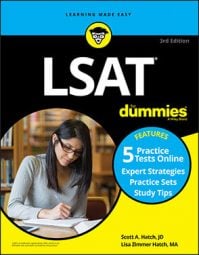You can score well on the LSAT logical reasoning questions without knowing the elements of informal logic, but if you understand a few terms and concepts, you’ll score even higher. You really just need to know the two basic components of a logical argument and a few methods of coming up with a conclusion.
The elements of an argument
A logical argument consists of premises and a conclusion, and when you’re analyzing arguments, identifying what parts are premises and what makes up the conclusion can help. The premises give the supporting evidence that you can draw a conclusion from. You can usually find the conclusion in the argument because it’s the statement that you can preface with “therefore.” Take a look at this simple argument:
All runners are fast. John is a runner. Therefore, John is fast.
The premises in the argument are “All runners are fast” and “John is a runner.” You know this because they provide the supporting evidence for the conclusion that John is fast, which is the sentence that begins with “Therefore.” You can try adding “therefore” to any statement you believe is the conclusion to see whether the argument makes sense.
Types of reasoning
Each logical argument has premises and a conclusion, but not every argument comes to a conclusion in the same way. For the purposes of the LSAT, you should be familiar with two basic types of logical reasoning: deductive and inductive. LSAT logical reasoning questions primarily test your inductive reasoning ability.
Deductive reasoning
In deductive reasoning, you come up with a specific conclusion from more-general premises. The great thing about deductive reasoning is that if the premises are true, the conclusion must be true! The following is an example of a deductive reasoning argument:
All horses have hooves. (General premise)
Bella is a horse. (More specific premise)
Therefore, Bella has hooves. (Very specific conclusion)
If the premise that all horses have hooves is true, and if Bella is, in fact, a horse, then it must be true that Bella has hooves. The same holds true for all examples of deductive reasoning. Here’s another example:
All who take the LSAT must complete a writing sample. (General premise)
You’re taking the LSAT. (More specific premise)
Therefore, you have to complete a writing sample. (Very specific conclusion)
This example shows the relationship between the truth of the premises and that of the conclusion. The first premise is categorically true: The LSAT requires you to write an essay. The second premise, however, may not be true. Remember, in deductive reasoning, the conclusion must be true if the premises are true. If you take the test, you have to write an essay, so this argument is valid.
Inductive reasoning
In deductive reasoning, you draw a specific conclusion from general premises. With inductive reasoning, you do just the opposite; you develop a general conclusion from specific premises.
Inductive reasoning differs from deductive reasoning in that the conclusion in an inductive reasoning argument could be false, even if all the premises are true. With inductive reasoning, the conclusion is essentially your best guess. That’s because an inductive reasoning argument relies on less complete information than deductive reasoning does. Consider this example of an inductive argument:
Bella is a horse and has hooves. (Specific premise)
Smoky is a horse and has hooves. (Specific premise)
Nutmeg is a horse and has hooves. (Specific premise)
Shadow is a horse and has hooves. (Specific premise)
Therefore, it is likely that all horses have hooves. (General conclusion)
Because an inductive argument derives general conclusions from specific examples, you can’t come up with a statement that “must be true.” The best you can say, even if all the premises are true, is that the conclusion can be or is likely to be true.
To excel on the LSAT, you want to get familiar with these three methods of inductive reasoning:
Cause-and-effect arguments: This argument concludes that one event is the result of another. These types of arguments are strongest when the premises prove that an event’s alleged cause is the most likely one and that there are no other probable causes.
Analogy arguments: This argument tries to show that two or more concepts are similar so that what holds true for one is true for the other. The argument’s strength depends on the degree of similarity between the persons, objects, or ideas being compared.
For example, in drawing a conclusion about Beth’s likes, you may compare her to Alex: “Alex is a student, and he likes rap music. Beth is also a student, so she probably likes rap music, too.” Your argument would be stronger if you could show that Alex and Beth have other similar interests that apply to rap music, like hip-hop dancing or wearing bling.
Statistical arguments: This argument relies on numbers to reach a conclusion. These types of arguments claim that what’s true for the statistical majority is also true for the individual. But because these are inductive reasoning arguments, you can’t prove that the conclusions are absolutely true. When you analyze statistical arguments on the LSAT, focus on how well the given statistics apply to the conclusion’s circumstances.
For instance, if you wanted people to buy clothing through your website, you may make this argument: “In a recent study of consumers’ preferences, 80 percent of shoppers surveyed said they prefer to shop online; therefore, you’ll probably prefer to buy clothes online.” You’d support your conclusion if you could show that what’s true for the majority is also true for an individual.
To do well on logical reasoning questions, you need to recognize stated premises, assumed premises, and conclusions in arguments; determine the method of reasoning; and establish whether premises adequately support the conclusion.

